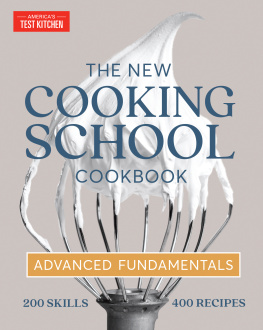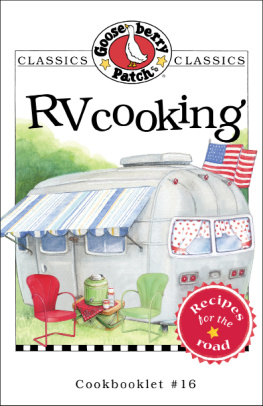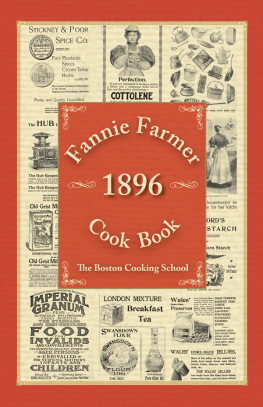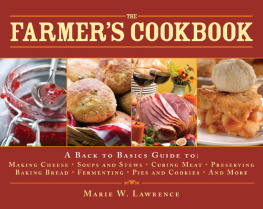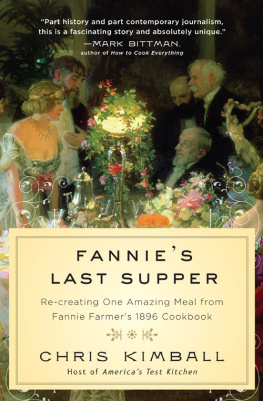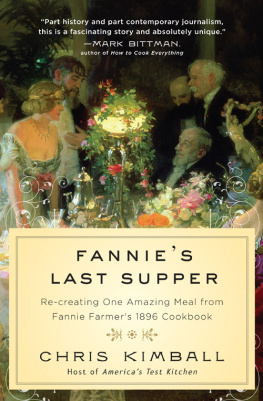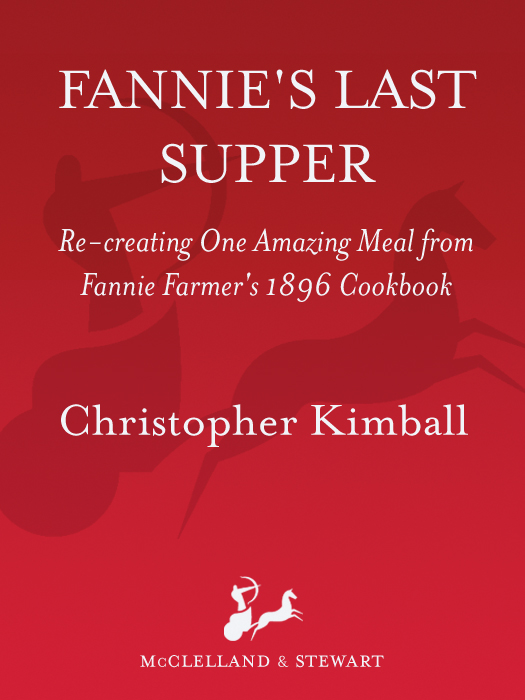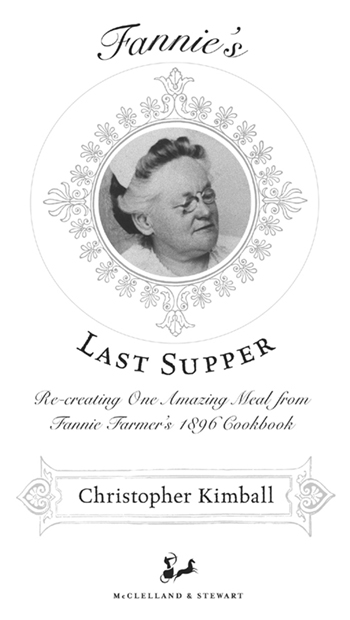Copyright 2010 by Christopher Kimball
Published simultaneously in the United States by Hyperion Books.
All rights reserved. The use of any part of this publication reproduced, transmitted in any form or by any means, electronic, mechanical, photocopying, recording, or otherwise, or stored in a retrieval system, without the prior written consent of the publisher or, in case of photocopying or other reprographic copying, a licence from the Canadian Copyright Licensing Agency is an infringement of the copyright law.
Library and Archives Canada Cataloguing in Publication
Kimball, Christopher
Fannies last supper : re-creating one amazing meal from Fannie Farmers 1896 cookbook / Chris
Kimball.
eISBN: 978-1-55199-360-7
1. Christmas cookery. 2. Entertaining. I. Farmer, Fannie
Merritt, 1857-1915 II. Title.
TX739.2.C45K52 2010 641.5686 C2010-901565-7
We acknowledge the financial support of the Government of Canada through the Book Publishing Industry Development Program and that of the Government of Ontario through the Ontario Media Development Corporations Ontario Book Initiative. We further acknowledge the support of the Canada Council for the Arts and the Ontario Arts Council for our publishing program.
McClelland & Stewart Ltd.
75 Sherbourne Street
Toronto, Ontario
M5A 2P9
www.mcclelland.com
v3.1
For Kate
ACKNOWLEDGMENTS

FIRST OFF, THANKS TO MY WIFE, ADRIENNE, FOR MANAGING the restoration of our 1859 bowfront in Boston, including sleuthing about for the silver, crystal, and china required to set a properly Victorian table. Working with my researcher, Meg Ragland, is like having ones own historical drive-thru: facts, figures, and photos were instantly produced, no matter how offbeat the request. Mike Ehlenfeldt is an inspired man-of-all-trades, assembling and training the service staff as well as researching and procuring the wines, liqueurs, and cheeses, plus supervising the creation of our beloved ice mermaid, the woman Jos Andrs fell in love with. Thanks, Mike. David Erickson lovingly restored the large Number 7 cookstove that was the heart and soul of our enterprise. He is an artist of cast iron. My long-term test cook, Jeanne Maguire, also contributed mightily, especially with many of the daily Victorian recipes that appear in this book.
I owe a huge debt to all those who actually cooked the dinner, including sous-chef Keith Dresser, Andrea Geary, Dan Souza, Yvonne Ruperti, and Andrew Janjigian, with Marie Eleana and her son Ryan handling cleanup. Big thanks also to the waitstaff, including Mikes wife, Cindy, along with Jake McDowell, Debbie McDowell, Emile Arktinsal, and Melissa Klein. A special thanks to Yvonne for reverse engineering the spectacular Mandarin Cake and to Andrea for spending weeks playing with jellies and homemade calves foot gelatin. And when goose was no longer available, the folks at DArtagnan saved the day.
Thanks to all of the folks at DGA Productions for filming the evening and putting together the public television special, with special thanks to Michael Rothenberg, Jan, Elena, and the entire crew. Their wit and goodwill, not to mention their expertise, were deeply appreciated.
David Black, my agent, gets the credit for initiating this project and bringing it to life. He is one of the few people to whom I actually listen when he says, Rewrite, rewrite, rewrite. Leslie Wells, my editor at Hyperion, proved that great editors still exist at New York publishing housesshe transformed a mediocre manuscript into something vastly better but you, the reader, can be the judge. And more than a small thanks goes to Deborah Broide, my longtime publicity director and good friend.
Last, but by no means least, I owe a rich debt of gratitude to my culinary partner on this project, Erin McMurrer. Each day in the kitchen, Erin brought her sense of culinary adventure, her goodwill, and her rigorous approach to test cooking married to a buoyant playfulness that made this project both possible and the most fun I have had in years. Thanks, Fannie!
Contents

A Culinary Time Machine
A Seat at the Victorian Table
The Punch Bowl
In Which We Move to the Wrong Side of the Tracks
Oysters
Fannie Farmer Is Born, Survives Polio, Takes Over the Boston Cooking School, and Sells Over 360,000
Copies of The Boston Cooking-School Cook Book
Mock Turtle Soup
A Walking Tour of Fannie Farmers Boston
Rissoles
Fannie Farmer Sexes up Her Food:
Was She Really the Mother of Level Measurements?
Lobster lAmricaine
Eating out in Boston and Why the Tavern Club Owned a Bear
Saddle of Venison
The Old Boston, the New Boston, and Social Nudism
Wood-Grilled Salmon
How to Cook on a Short, Hot Coal Cookstove
Fried Artichokes
Its 1896: Lets Go Shopping
Canton Punch
Everyday American Food, 1896:
Try the Roast and Beans but Skip the Fish
Roast Stuffed Goose
The Transformation of the Victorian Kitchen:
The Lady of the House Rolls Up Her Sleeves
Wine Jelly
The Science of Cooking, According to Fannie
Cake
Technology Transforms the Victorian Pantry
Coffee, Cheese, and Cordials
The Coffee Industry Awakens America
The Dinner Party
Amy Shakes Her Jelly and
Jos Andrs Falls in Love with a Mermaid
Requiem for Fannie
Fannies Last Word

A Culinary Time Machine

A Seat at the Victorian Table
A high Victorian dinner party was a modern re-creation of the ancient ritual of class and culinary artistry, displaying the plumage of high society while underlining the rigid rules of proper social intercourse. It was tails for the gentlemen and full dress costume for the ladies. One was expected to arrive neither early nor more than fifteen minutes late. When dinner was announced, the guests were led in procession from parlor to dining room, the host escorting the honored lady of the evening. The standard twelve courses were to be served briskly, in no more than two hours, yet there were few restraints on the amount of silverware used, with up to 131 separate pieces per setting in myriad styles from neoclassical, Persian, and Elizabethan to Jacobean, Japanese, Etruscan, and even Moorish. The rules of behavior were well known to all diners: one was never to appear greedy, draining the last drop from a wineglass or scraping the final morsel from the plate; one never ate hurriedly, which implied uncontrolled hunger; and since meal preparation was not something to be shown in public, plates were prepared out of view.
Within this rigid construct, food was the creative spark, the manna for imagination, and the kitchen a place where one was at last allowed to express ones wildest desires. Victorian jellies with ribbons of colors and flavors, Bavarian cream fillings, and hundreds of custom molds were a culinary free-for-all, as was the sheer variety of a twelve-course menu, from oysters and champagne to fish, turtle, goose, venison, duck, chicken, beef, vegetables, salads, cakes, bonbons, coffee, and liqueurs, all carefully orchestrated from soup to crackers to provide an eclectic, wide-ranging array of tastes and textures. Among the very wealthy, these dinners occasionally crossed the line from artistic perfection to excess, with menus that included roasted lion, naked cherubs leaping out from live-nightingale pies, chimps in tuxedos feted as guests of honor, and gentlemen in black tie dining on horseback. The Victorian dinner table was a moment in time that encapsulated the dreams of a young countrythe radical pace of change from farm to city, from water to steam power, from local to international, from poor to richthat defined our nineteenth century, and this food, these menus, this dining experience have today remained dormant for over a century, just waiting to be rediscovered: the old cast-iron stove lit once again, the venison roasted, the geese plucked, and the dining table decorated using the furthest reaches of culinary imagination.


